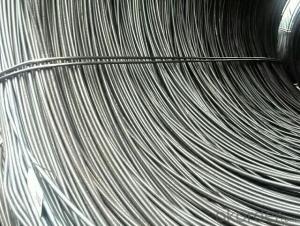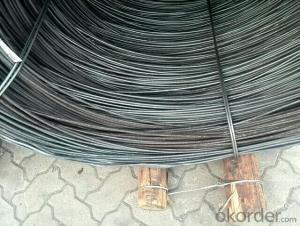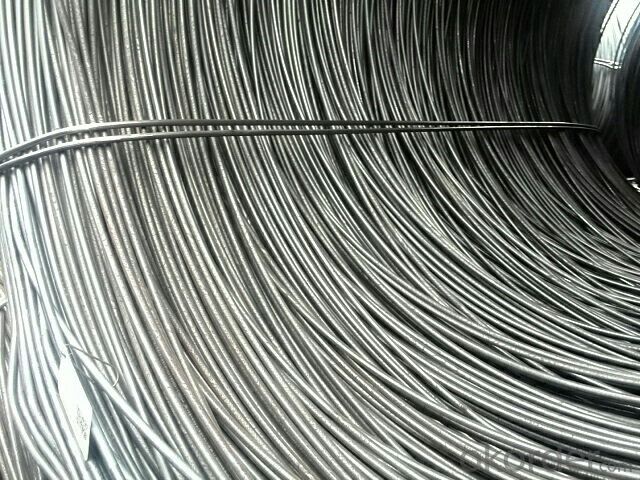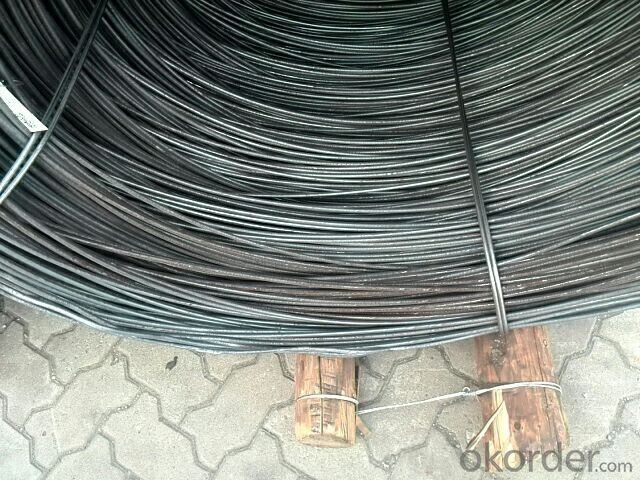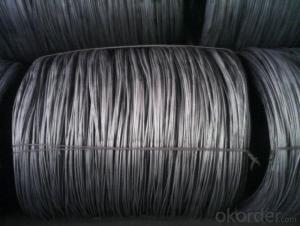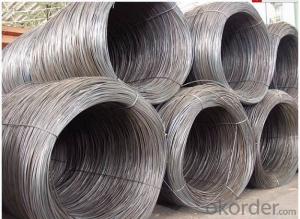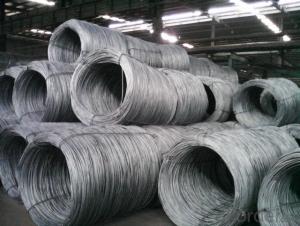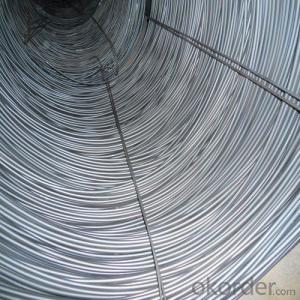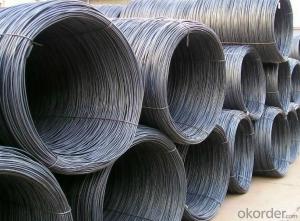Sae1006B and Q235 High quality Wire Rod
- Loading Port:
- Tianjin
- Payment Terms:
- TT OR LC
- Min Order Qty:
- 25 m.t
- Supply Capability:
- 20000 m.t/month
OKorder Service Pledge
OKorder Financial Service
You Might Also Like
Product Description:
OKorder is offering Sae1006B and Q235 High quality Wire Rod at great prices with worldwide shipping. Our supplier is a world-class manufacturer of steel, with our products utilized the world over. OKorder annually supplies products to European, North American and Asian markets. We provide quotations within 24 hours of receiving an inquiry and guarantee competitive prices.
Product Applications:
Sae1006B and Q235 High quality Wire Rodideal for structural applications and are widely used in the construction of buildings and bridges, and the manufacturing, petrochemical, and transportation industries.
Product Advantages:
Sae1006B and Q235 High quality Wire Rod are durable, strong, and resist corrosion.
Main Product Features:
· Premium quality
· Prompt delivery & seaworthy packing (30 days after receiving deposit)
· Corrosion resistance
· Can be recycled and reused
· Mill test certification
· Professional Service
· Competitive pricing
Product Description:
Specifications of Sae1006B and Q235 High quality Wire Rod :
Steel Grade: sae1006+sae1008B , Standard: GB Diameter: 5.5mm, 6.5mm, 7mm,8mm,9mm,10mm,12mm,14mm
Diameter Tolerance:±0.3mm 6.5mm can be drawing into 2mm/8.0mm can be drawing into 3mm
Brand Name: N-RIVER Place of Origin: Hebei, China Mainland Application: construction, building etc
Chemical Composition:
Please kindly find our chemistry of our material based on Q235 as below for your information
Trademark | Rank | Chemical composition (quality score) % | ||||||
C | Si | Mn | S | P | ||||
| ≤ |
| ≤ | ≤ | ||||
Q235 | A | 0.14-0.22 | 0.30 | 0.30-0.65 | 0.050 | 0.045 | ||
Q235 | B | 0.12-0.20 | 0.30 | 0.30-0.70 | 0.045 | 0.045 | ||
Trademark | Rank | Pulling Test | ||||||
Bend PointΔs/Mpa | Tensile Strength | Elongation Ratioδ5% | ||||||
Thickness (Diameter) /MM | Thickness (Diameter) /MM | |||||||
≤16 | 16-40 | ≤16 | 16-40 | |||||
≥ | ≥ | |||||||
Q235 | A | 235 | 225 | 375-500 | 26 | 25 | ||
Q235 | B | 235 | 225 | 375-500 | 26 | 25 | ||
Usage and Applications of Sae1006B and Q235 High quality Wire Rod :
After hot-rolled the products shaped into coil and delivery as finished product, including round, square, rectangular, hexagonal and so on. Since most of the products are round, it is generally called wire rod. Carbon steel wire rod is widely used in construction and manufacturing. Carbon steel wire rod is mainly used for reinforcement of reinforced concrete and welded structure or reprocessed (roberts , nail, etc.) materials, especially used to produce wire drawing, welding electrode, nails, spring, electronic, precise machinery parts and so on.
Packaging & Delivery of Sae1006B and Q235 High quality Wire Rod :
Packaging Detail: products are packed in coil and then shipped by container or bulk vessel
Each coil weight: 2-3MT
Delivery Detail: within 45 days after received deposit or LC.
Label: to be specified by customer, generally, each bundle has 1-2 labels
Trade terms: FOB, CFR, CIF
FAQ:
Q1: Why buy Materials & Equipment from OKorder.com?
A1: All products offered byOKorder.com are carefully selected from China's most reliable manufacturing enterprises. Through its ISO certifications, OKorder.com adheres to the highest standards and a commitment to supply chain safety and customer satisfaction.
Q2: Can stainless steel rust?
A2: Stainless does not "rust" as you think of regular steel rusting with a red oxide on the surface that flakes off. If you see red rust it is probably due to some iron particles that have contaminated the surface of the stainless steel and it is these iron particles that are rusting. Look at the source of the rusting and see if you can remove it from the surface.
Q3: How soon can we receive the product after purchase?
A3: Within three days of placing an order, we will begin production. The specific shipping date is dependent upon international and government factors, but is typically 7 to 10 workdays.
Images:
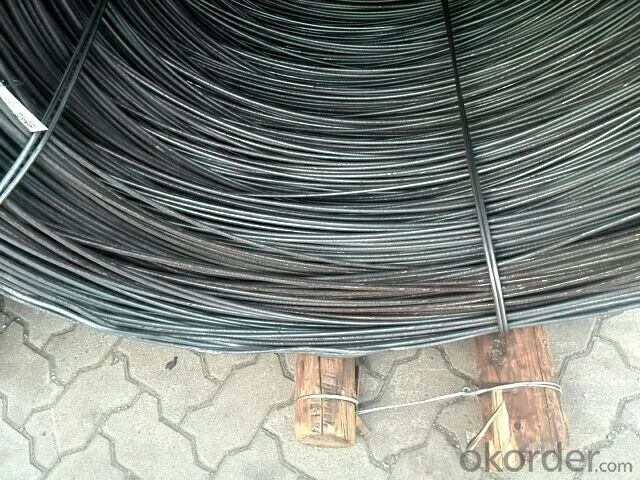
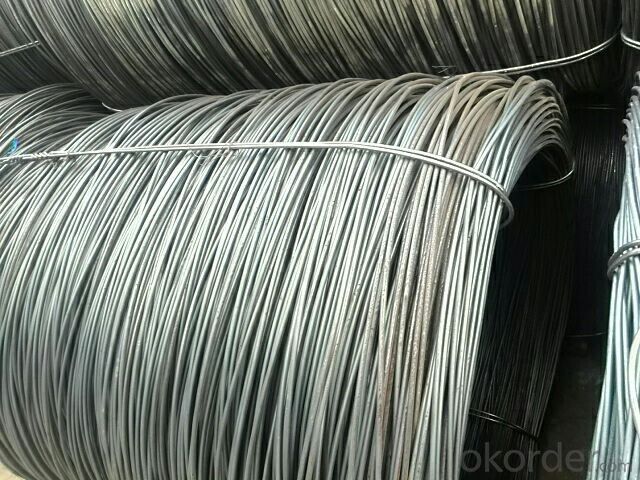
- Q: What are the main factors influencing the choice of steel wire rod packaging?
- The main factors influencing the choice of steel wire rod packaging include the weight and size of the wire rod, the required protection and safety during transportation, the storage conditions, the specific industry requirements, and the cost-effectiveness of the packaging solution.
- Q: What are the different types of wire mesh for architectural use made from steel wire rod?
- Steel wire rod is used to create several different types of wire mesh for architectural purposes. These options include: 1. Welded Wire Mesh: This wire mesh is formed by welding steel wire rods at their intersection points, resulting in a grid-like pattern. It is commonly utilized for applications such as fencing, partitions, and reinforcement. 2. Woven Wire Mesh: Woven wire mesh is produced by interweaving steel wire rods in an over-and-under fashion. It is known for its strength and durability, and is often employed for architectural screening, decorative panels, and infill panels. 3. Expanded Metal Mesh: By cutting and stretching a sheet of steel wire rod, expanded metal mesh is formed, creating diamond-shaped openings. It is lightweight and provides excellent ventilation and visibility, making it suitable for architectural facades, sunscreens, and walkways. 4. Perforated Metal Mesh: This type of wire mesh is created by punching holes into a sheet of steel wire rod. It offers a variety of hole patterns and sizes, allowing for customization and versatility. Perforated metal mesh is commonly used for architectural cladding, acoustic panels, and decorative screens. 5. Architectural Mesh: Architectural mesh encompasses a range of wire mesh products specifically designed for architectural applications. It can be manufactured using various techniques such as weaving, welding, and expanded metal processes. Architectural mesh is frequently utilized for building facades, sunscreens, balustrades, and interior design elements. All of these wire mesh options, made from steel wire rod and intended for architectural use, possess unique characteristics and can be tailored to meet specific design requirements. They offer strength, durability, and versatility, making them suitable for a wide array of architectural applications.
- Q: How is steel wire rod used in the manufacturing of wire forms for packaging?
- Steel wire rod is an essential material used in the manufacturing of wire forms for packaging. It serves as the base material for creating various wire products that are widely used in packaging applications. One of the primary uses of steel wire rod in packaging is the production of wire baskets and racks. These wire forms are commonly used for storing and transporting goods, providing a sturdy and reliable solution for packaging needs. The steel wire rod is processed and shaped into different forms and sizes to create these wire baskets and racks, which are then used for organizing and protecting various packaged items. Additionally, steel wire rod is also utilized in the production of wire hooks and clips. These wire forms are often used to secure packaging materials, such as plastic bags or boxes, preventing them from opening or spilling their contents during transportation. The durability and strength of steel wire rod make it an ideal material for creating these hooks and clips, ensuring that packaging remains intact and secure. Moreover, steel wire rod is employed in the manufacturing of wire ties, also known as twist ties or bag closures. These wire forms are commonly used in the packaging industry to seal bags, bundles, or packages, providing a simple yet effective way to keep items tightly sealed and protected. The flexibility and malleability of steel wire rod allow for easy bending and shaping into twist ties, making it an essential component in their production. Overall, steel wire rod plays a crucial role in the manufacturing of wire forms for packaging. Its strength, durability, and versatility make it a preferred material for creating various wire products used in packaging applications, such as baskets, racks, hooks, clips, and twist ties. By utilizing steel wire rod, packaging solutions can be designed to withstand the rigors of transportation and ensure the safe and secure handling of goods.
- Q: How is steel wire rod used in the production of wire ropes for marine applications?
- Steel wire rod is used in the production of wire ropes for marine applications as it serves as the raw material for manufacturing the individual wires that are twisted together to form the rope. The steel wire rod undergoes a series of processes including drawing, heat treatment, and galvanizing to enhance its strength, flexibility, and corrosion resistance. These wire ropes are then utilized in various marine applications such as ship mooring, lifting heavy loads, and securing offshore structures due to their high tensile strength and durability in harsh marine environments.
- Q: How is steel wire rod used in the manufacturing of wire mesh sieves?
- Steel wire rod is used in the manufacturing of wire mesh sieves as it is the primary material from which the wires of the sieve are made. The steel wire rod is first drawn through a series of dies to reduce its diameter and increase its length, creating thin wires. These wires are then woven together to form the mesh pattern of the sieve, providing strength, durability, and the ability to withstand high temperatures and pressure.
- Q: How is steel wire rod used in the manufacturing of wire for surgical sutures?
- The manufacturing process of wire for surgical sutures heavily relies on steel wire rod, an indispensable component. The wire rod undergoes multiple stages to convert it into the top-notch wire used in sutures. To start with, careful selection of the steel wire rod is imperative to ensure it meets the required specifications for surgical sutures. Typically, the rod is constructed from stainless steel, which possesses exceptional strength, durability, and corrosion resistance. Once the appropriate steel wire rod is chosen, it goes through a series of processes to shape and refine it. The rod is drawn through a sequence of dies that gradually reduce its diameter to the desired size for surgical sutures. This process, known as wire drawing, is pivotal in achieving the precise diameter and smooth surface required for sutures. After the wire is drawn to the correct diameter, it undergoes thorough cleaning and inspection to detect any defects or impurities. This meticulous examination guarantees that the wire is devoid of any contaminants that might jeopardize its integrity and safety for medical purposes. The subsequent step involves coating the wire with a biocompatible material to enhance its performance and minimize potential adverse reactions within the human body. The choice of coating material, such as silicone or polymers, varies depending on the specific requirements of the surgical sutures. Once the wire is coated, it is wound onto spools or bobbins, prepared for further processing into sutures. The wire is handled with utmost care and packaged in a sterile environment to preserve its cleanliness and prevent any contamination. Finally, the wire is dispatched to the suture manufacturing facility, where it is precisely cut into lengths and further processed to produce the final surgical sutures. These sutures are then packaged and sterilized, ready for use in diverse surgical procedures. In conclusion, steel wire rod plays a crucial role in the production of wire for surgical sutures. Through a series of processes, the rod is transformed into high-quality wire with the necessary diameter, surface finish, and biocompatible coating. This wire is subsequently utilized to manufacture sterile and dependable sutures that are indispensable in various medical procedures.
- Q: What are the different surface protection materials used for steel wire rod?
- Some common surface protection materials used for steel wire rods include coatings such as zinc, galvanized, or polymer-based coatings. These materials provide a protective layer to prevent corrosion and enhance the durability of the wire rods. Additionally, other surface protection methods such as electroplating or heat treatment may also be utilized in specific applications to enhance the surface properties of the wire rod.
- Q: What are the different tensile strengths available for steel wire rod?
- The tensile strengths available for steel wire rod can vary depending on the specific steel grade and manufacturing process. However, common tensile strengths for steel wire rod range from around 500 MPa (megapascals) to 2000 MPa.
- Q: What are the different types of steel wire rod surface cleaning methods for wire drawing?
- In the wire drawing process, various methods are commonly employed to clean the surface of steel wire rods. These methods play a vital role in eliminating impurities and ensuring a polished and superior final product. 1. Acid Pickling: Acid pickling is extensively utilized to clean steel wire rod surfaces. This technique involves immersing the wire rod in a solution of hydrochloric acid, which effectively eliminates rust, scale, and oxide layers. By removing surface impurities, acid pickling prepares the wire rod for subsequent wire drawing processes. 2. Electrolytic Cleaning: Another prevalent method for purifying steel wire rod surfaces is electrolytic cleaning. This process entails passing an electric current through the wire rod submerged in an electrolytic solution. The current effectively dissolves and separates contaminants from the wire rod surface. Electrolytic cleaning is especially effective in eliminating oils, greases, and other organic substances. 3. Mechanical Cleaning: Mechanical cleaning involves physically scrubbing and cleaning the wire rod surface using abrasive materials or brushes. This technique can be performed manually or with specialized machinery. Mechanical cleaning is highly efficient in removing stubborn dirt, rust, and scale from the wire rod. 4. Shot Blasting: Shot blasting is a process that involves propelling small metallic or non-metallic particles onto the wire rod surface at high velocities. The impact of these particles effectively eliminates surface contaminants, scale, and rust. Shot blasting is particularly useful for cleaning wire rods with intricate shapes or hard-to-reach areas. 5. Ultrasonic Cleaning: Ultrasonic cleaning employs high-frequency sound waves to generate tiny bubbles in a cleaning solution. These bubbles collapse upon contact with the wire rod surface, creating a scrubbing action that removes contaminants. Ultrasonic cleaning is highly effective in eliminating fine particles, oils, and greases. Each of these steel wire rod surface cleaning methods possesses its own advantages and limitations. The selection of the appropriate method depends on various factors, such as the type of contaminants, wire rod composition, and desired level of cleanliness. Choosing the right cleaning method is crucial to achieve optimal wire drawing performance and produce high-quality wire products.
- Q: How is steel wire rod used in the production of tire cords?
- Tire cords rely on steel wire rod, an indispensable element, for their production. These cords are embedded within the rubber of tires to offer strength and support. The steel wire rod undergoes a sequence of steps to achieve the desired form for tire cord manufacturing. To begin with, the steel wire rod undergoes hot rolling, which reduces its diameter and increases its length. This process enhances the wire rod's strength and flexibility, making it suitable for tire cord applications. Following hot rolling, the wire rod is subjected to a heat treatment known as patenting. This treatment improves the wire's mechanical properties, such as tensile strength and elasticity, ensuring it can endure the demanding conditions tires face. Once appropriately processed, the steel wire rod is drawn through a series of dies to attain the desired diameter and surface finish. This drawing process further enhances the wire's strength and surface quality, meeting the strict requirements for tire cord production. Next, the drawn steel wire rod is coated with a layer of brass or zinc to enhance its adhesion to the rubber compound used in tire manufacturing. This coating also provides corrosion resistance, extending the lifespan of the tire cords. Lastly, the coated steel wire rod is twisted into cord structures with multiple strands, forming the tire cord. These cords are then embedded into the rubber during the tire manufacturing process. They play a vital role in reinforcing the tire, enabling it to withstand internal pressure, external forces, and maintain stability during vehicle movement. In conclusion, steel wire rod is an essential material in the production of tire cords. Through a series of processing steps, including hot rolling, heat treatment, drawing, and coating, the wire rod is transformed into durable and high-strength cords. These cords are embedded within the rubber of tires to provide crucial reinforcement and support, ensuring the tires can endure the challenging road conditions they encounter.
Send your message to us
Sae1006B and Q235 High quality Wire Rod
- Loading Port:
- Tianjin
- Payment Terms:
- TT OR LC
- Min Order Qty:
- 25 m.t
- Supply Capability:
- 20000 m.t/month
OKorder Service Pledge
OKorder Financial Service
Similar products
Hot products
Hot Searches
Related keywords

